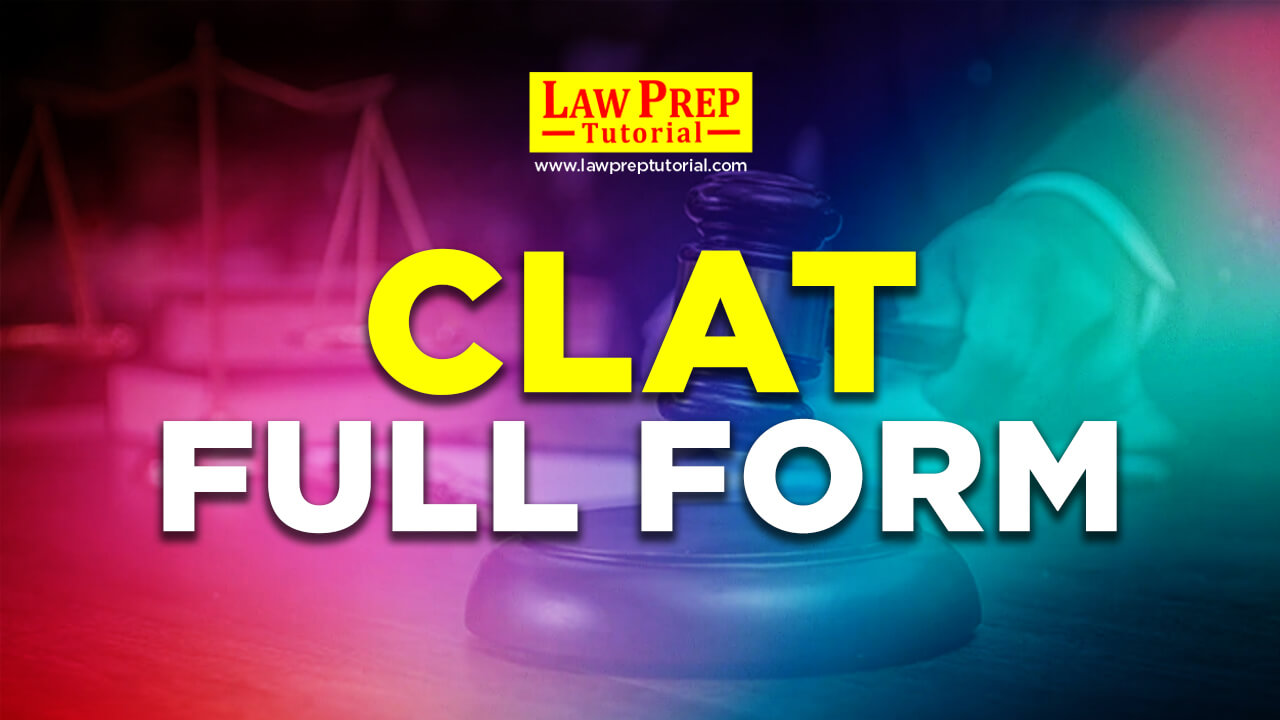Knowing the full form of CLAT, especially in law education, is crucial for aspiring law students. Hence, let’s understand what CLAT stands for, along with knowing its significance and implications for those looking to pursue a career in law.
CLAT Full Form
The full form of CLAT is the Common Law Admission Test.
It is a standardized national-level entrance exam for students aspiring to pursue law degrees at undergraduate and postgraduate levels. Conducted by the Consortium of NLUs, CLAT is the primary exam for admission into prestigious National Law Universities (NLUs) in India.
The test evaluates a candidate’s aptitude and skills necessary for legal education. The CLAT exam focuses on assessing various areas, including:
- Legal Reasoning
- English
- Logical Reasoning
- Current Affairs and GK
- Quantitative Techniques
Understanding the full form of CLAT exam is crucial for all law aspirants as it encapsulates the essence of what the examination aims to achieve.
Upcoming CLAT Exams:
Full Form of CLAT UG
The full form of CLAT UG is “Common Law Admission Test for Undergraduate.”
It is specifically designed for students who wish to pursue an undergraduate degree in law, such as the Bachelor of Laws (LLB).
This exam is the primary route for school students seeking admission to the five-year integrated LLB programs offered by the participating NLUs.
Useful Tip For You:
| Timetable for CLAT Preparation |
| Self-study Tips for CLAT |
| How to Read Newspapers for CLAT and Make Notes? |
| Time Management Tips for CLAT |
| How to Improve Vocabulary for CLAT |
Full Form of CLAT PG
The full form of CLAT PG is “Common Law Admission Test for Postgraduate.”
This exam is for students who are interested in pursuing postgraduate law degrees, specifically the Master of Laws (LLM) program. CLAT PG is an advanced level examination that assesses candidates on their comprehension and analytical abilities of legal knowledge at a graduate level.
CLAT PG is crucial for law graduates seeking specialized legal education and looking to enhance their professional prospects in academia, litigation, corporate law, and other legal specializations.
This exam serves as a gateway to securing admission in the LLM programs offered by participating NLUs across India, providing a platform for graduates to further their legal expertise and qualifications.
Find the complete breakdown of CLAT UG vs CLAT PG.
CLAT Exam Details
The following are all the details and information about CLAT test:
| Aspect | Details |
| Exam Name | Common Law Admission Test (CLAT) |
| Conducting Body | Consortium of NLUs (National Law Universities) |
| Frequency | Once a year |
| Exam Level | National |
| Mode of Exam | Offline (Pen and paper-based) |
| Duration | 2 hours |
| Exam Purpose | Admission to undergraduate and postgraduate law programs at NLUs |
| CLAT Eligibility | UG: 10+2 or equivalent with 45% (40% for SC/ST) |
| PG: LL.B or equivalent with 50% (45% for SC/ST) | |
| CLAT Age Limit | UG: No upper or lower age limit |
PG: No upper or lower age limit | |
| Total Questions | UG: 120 MCQs |
| PG: 120 MCQs | |
| Sections | UG: English, Current Affairs, Legal Reasoning, Logical Reasoning, Quantitative Techniques |
| PG: Jurisprudence, Constitutional Law, Other Law Subjects | |
| Marking Scheme | +1 for correct answer, -0.25 for wrong answer |
| CLAT Exam Date | Expected in December 2024 (exact date to be announced for this year) |
| Application Period | Generally from July to November 2024 (exacty period to be announced for this year) |
| CLAT Registration Fee | INR 4,000 for General/OBC/PWD/NRI/PIO/OCI candidates |
| INR 3,500 for SC/ST/BPL candidates | |
| CLAT Admit Card Release | Two to three weeks before the exam |
| CLAT Result Declaration | Expected in January 2025 (exact date to be announced) |
| Counselling Start | A few weeks after result declaration |
| Participating Colleges/Universities | 24 NLUs42 Affiliated Universities |
CLAT Full Form in Hindi
CLAT का पूरा नाम “कॉमन लॉ एडमिशन टेस्ट” होता है।
CLAT Full Form in Tamil
CLAT இன் முழு வடிவம் தமிழில் “பொது சட்ட நுழைவுத் தேர்வு” ஆகும்.
Related Acronyms or Full Forms in CLAT
LLB (Bachelor of Laws)
The degree awarded upon completion of the undergraduate law course.
LLM (Master of Laws)
The advanced law degree awarded upon completion of postgraduate studies in law.
AILET (All India Law Entrance Test)
The entrance test conducted by National Law University Delhi, which is not a part of the CLAT consortium.
LSAT (Law School Admission Test)
A standardized test used for law school admissions in various countries, including the USA. It is also accepted by some law schools in India as an alternative to CLAT.
NLU (National Law University)
Refers to any of the National Law Universities in India that offer law degrees. Most NLUs use CLAT scores for admissions.
GK (General Knowledge)
A section within the CLAT exam that tests the candidate’s knowledge of current affairs and general awareness.
LR (Legal Reasoning)
A section within the CLAT that assesses a candidate’s ability to logically deduce and reason within legal contexts.
CR (Critical Reasoning)
Part of the logical reasoning section that tests the ability to critically analyze arguments and reasoning.
QA (Quantitative Ability)
A section in the CLAT that evaluates numerical ability and basic arithmetic skills.
MCQ (Multiple Choice Questions)
A type of question format used in CLAT where candidates choose the correct answer from several options.
VC (Vice-Chancellor)
The title for the head of many National Law Universities; often plays a significant role in the administration of the CLAT Consortium.
EC (Executive Committee)
The governing body within the CLAT Consortium that makes key decisions about the conduct and administration of the exam.
MOU (Memorandum of Understanding)
An agreement between the NLUs at the inception of CLAT to conduct the entrance test collaboratively.
IPR (Intellectual Property Rights)
An area of law that can be a subject focus in postgraduate legal studies (LLM) and sometimes covered under the legal reasoning or GK sections of CLAT.
IPC (Indian Penal Code)
A section of Indian law that deals with criminal law, often covered under the legal aptitude or legal reasoning sections of CLAT.
CPC (Civil Procedure Code)
Part of the law curriculum and sometimes examined in CLAT, especially relevant for candidates pursuing postgraduate legal studies.
CRPC (Criminal Procedure Code)
Similar to the IPC, it’s crucial for law students and is often covered in the legal reasoning sections of the CLAT exam.
RTI (Right to Information)
An important aspect of governance and public administration covered under General Knowledge in CLAT.
ADR (Alternative Dispute Resolution)
A method of resolving disputes outside the judiciary, which is a key area in modern legal studies and sometimes featured in advanced legal reasoning questions in CLAT PG.
FAQs About CLAT Full Form
The full form of CLAT is “Common Law Admission Test.”
CLAT UG stands for “Common Law Admission Test for Undergraduate,” which is the exam conducted for admissions into undergraduate law programs like the Bachelor of Laws (LLB).
CLAT PG stands for “Common Law Admission Test for Postgraduate,” referring to the entrance exam for postgraduate law courses such as the Master of Laws (LLM).
No, NLU Delhi does not participate in CLAT and conducts its own entrance exam called AILET (All India Law Entrance Test).
Yes, CLAT covers subjects including English, General Knowledge, Legal Reasoning, Logical Reasoning, and Quantitative Techniques.
CLAT is conducted once a year, typically in December.
The CLAT Consortium is responsible for the conduct of the CLAT exam. It consists of representatives from participating NLUs and oversees the organization, question setting, and administration of the exam.
Wrapping Up:
Understanding the full forms and related acronyms associated with the CLAT exam is essential for every law aspirant. These terms provide a foundation for the knowledge required to successfully navigate the complexities of law entrance exams.
As you prepare to tackle this exam with its diverse and challenging content, consider enhancing your preparation strategy with specialized offline or online CLAT coaching by Law Prep Tutorial.
Joining Law Prep Tutorial offers you targeted training, expert guidance, and comprehensive resources personalized to the CLAT exam pattern, ensuring you are well-prepared to achieve your legal education goals.
Read Next:



